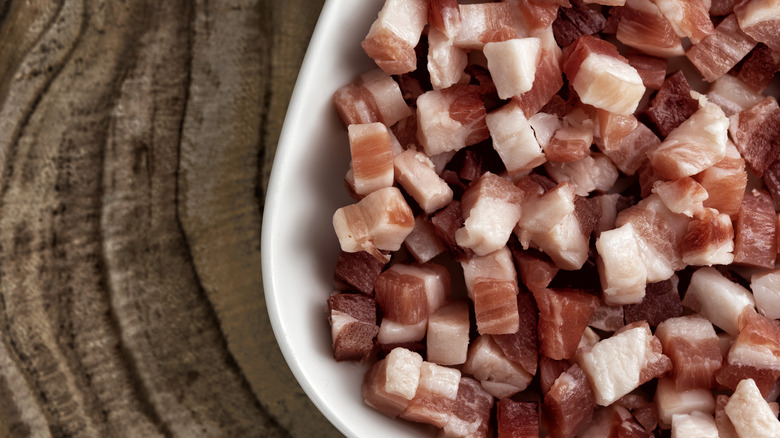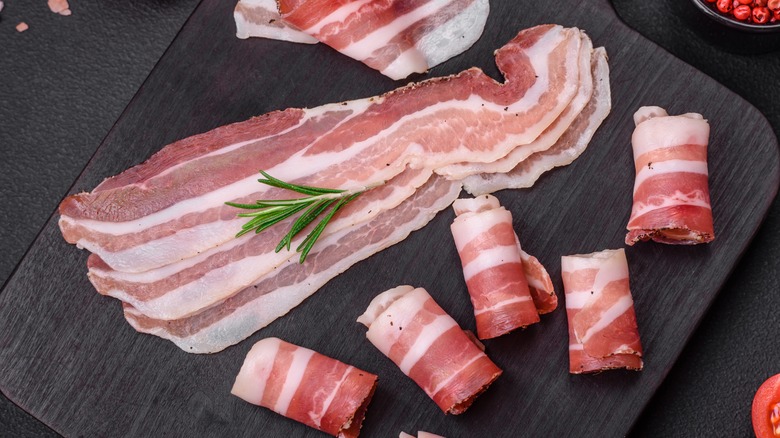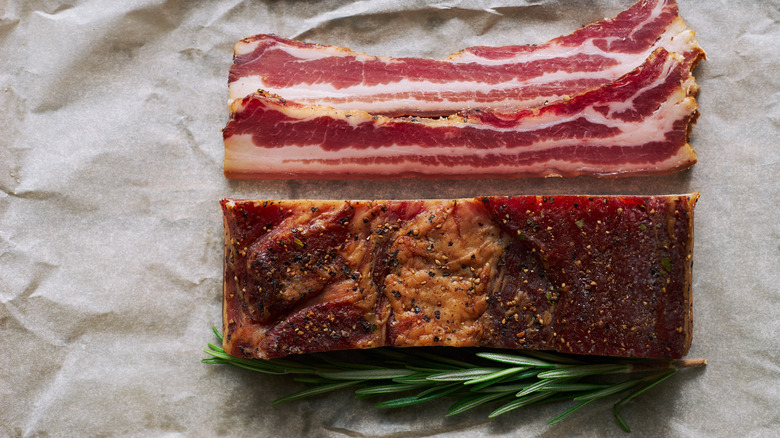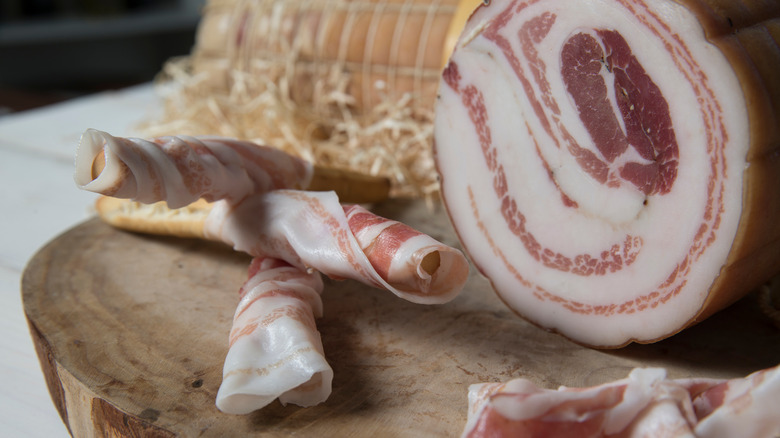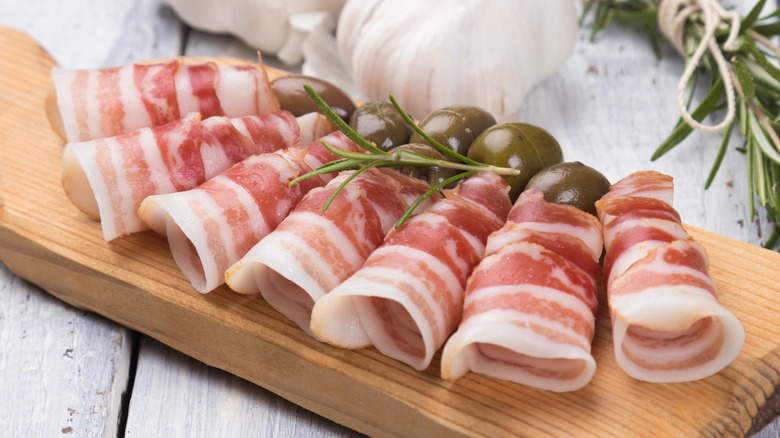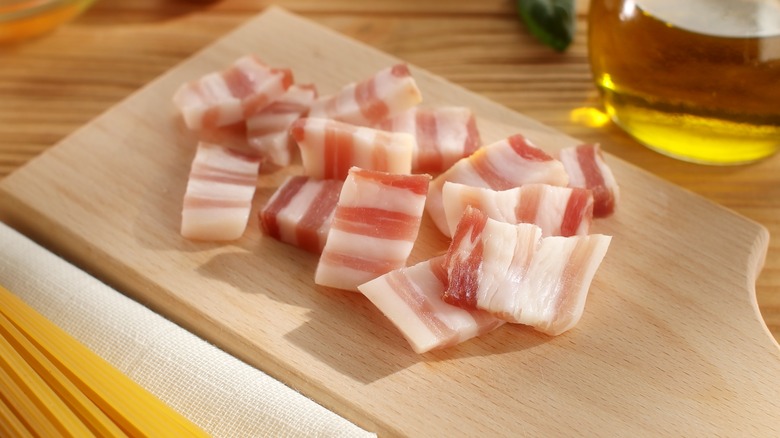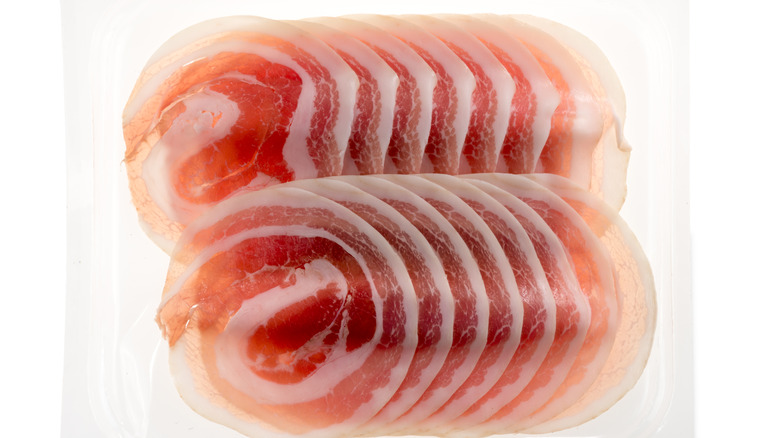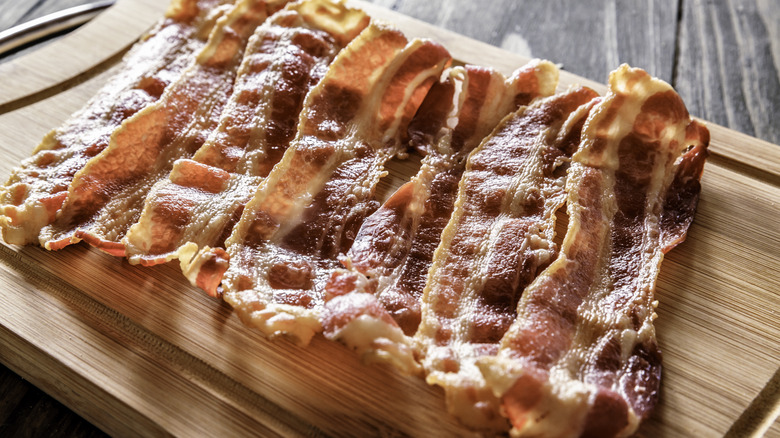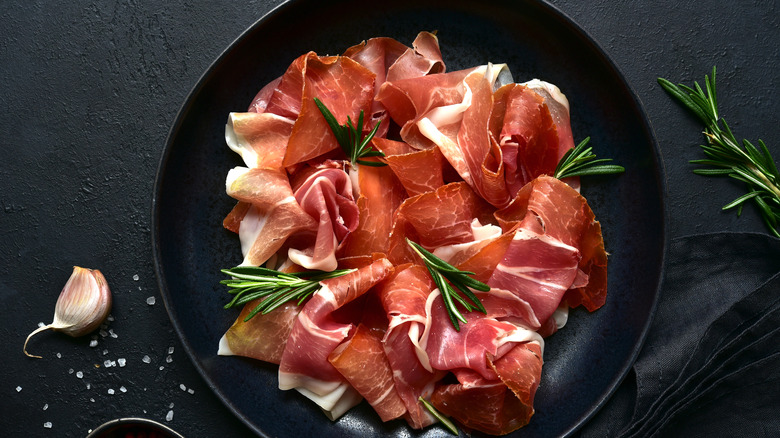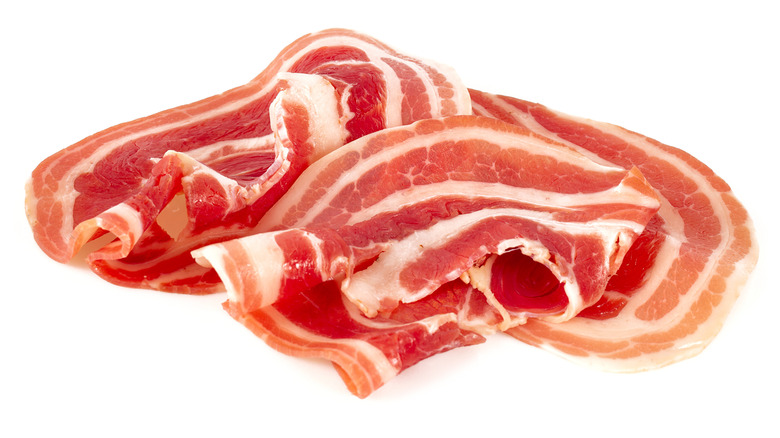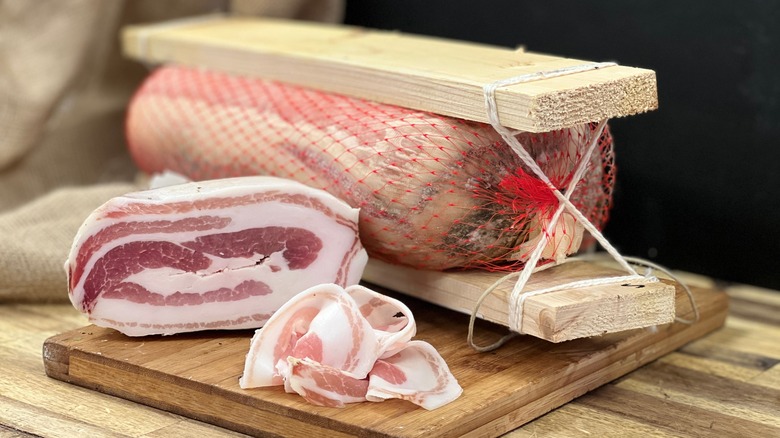What Is Pancetta And How Is It Different From Bacon?
Maybe you've eaten a slice of pancetta off of a fancy charcuterie board, or you've seen tiny cubes of it sprinkled on top of a salad for some extra crispiness. Or, maybe you've tasted the salty bites mixed into a carbonara pasta. If you've had pancetta, then you know this fatty, salt-cured meat is quite a treat.
Its deep pork flavor can be used to pack rich, umami notes into a variety of dishes, from pasta sauces to soups and stews. It can replace other meats in the dishes you already enjoy, or can be used as a flavor enhancer in traditional Italian recipes. So what the heck is pancetta, and why should you add it to your grocery list immediately?
It's simple enough to describe, but the world of cured meat — and even just the world of Italian pork products — can get very confusing quickly. Pancetta, prosciutto, guanciale, capocollo, the list goes on. Here's everything you need to know about pancetta.
What is pancetta?
If you appreciate all things bacon, then pancetta is definitely an ingredient you'll want to know more about. It can be used in place of bacon in many recipes and can seriously upgrade your culinary creations.
Pancetta comes from the belly of the pig, which is where it gets its name – pancia is Italian for paunch. Pancetta is salt cured with an array of other flavors, including fennel, chili, and nutmeg, which create its sought-after flavor. Although it is similar to bacon in many ways, there is one distinct difference — pancetta is not smoked.
There are two main forms of pancetta – arrotolata which is rolled, and stesa, meaning flat. Generally speaking, pancetta arrotolata most closely resembles the rashers of bacon that we are familiar with, while pancetta stesa tends to be diced into little cubes of delicious flavor that are perfect for throwing into sauces and savory dishes.
What does pancetta taste like?
Being cut from the belly of the pig, pancetta has a distinctive pork flavor, but it is surprisingly subtle. Unlike bacon, pancetta doesn't have a strong smoky taste, so it is unlikely to overpower other ingredients. It has delicate salty notes running through it, along with the flavors of the spices used to cure it.
The key to pancetta's alluring flavor is its fat content. The fat melts as it cooks, infusing other ingredients with its delightful bacon-like notes and creating a depth of flavor within the dish. For this reason it is often added to Italian pasta sauces near the start of cooking, to allow the fat to slowly melt as the sauce cooks, and create a complex flavor profile throughout the whole dish.
If you're looking for the bold smokiness that bacon provides, you won't find it in pancetta. But if an understated buttery flavor with a touch of saltiness is right up your street, pancetta is sure to become a staple in your kitchen.
How is pancetta made?
The first step in making pancetta is to salt the pork belly meat and let it sit for several days. This preserves the meat by drawing out the water, preventing bacteria growth, and concentrating the flavor in the process.
After salt-curing, pancetta is usually hung dry to age a bit longer in a blend of curing seasonings and spices like pepper, chili flakes, fennel seed, rosemary, and juniper berries. At this point, the meat is often rolled, giving pancetta its signature fat spiral. The aromatic rub that sits on the pork while it hangs to air dry for several months imparts more flavor to the meat itself and gives it its distinct and delicious taste. Often the meat is rolled, which gives it that signature spiral of fat once it's sliced.
You'll usually see pancetta sold in either flat slices (similar to bacon) or diced into tiny cubes. Because it's cured with salt, which preserves it and makes it safe to eat, pancetta can be eaten raw — but you can also cook it if you like.
Where to buy pancetta
You should be able to find pancetta in most major grocery stores. Similar to prosciutto or salami, it's usually placed in or near the deli section of the store with other cured meats, deli meats, and cheeses. If you don't have any luck there, try the international section since pancetta is an Italian-made product. And when in doubt, you can always order it online.
If your grocery store doesn't carry it or if you're interested in something more freshly sliced or customized, you should also be able to buy pancetta at your local butcher shop. The types and varieties of pancetta will vary from shop to shop, and you can have it hand-sliced or buy it in larger blocks to slice at home.
Once opened, pancetta can last in the fridge for up to three weeks, but its flavor and freshness will be best if consumed within 10 days (more on that later).
How to cook with pancetta
The beauty of pancetta is that depending on which kind you buy, it can be prepared raw or cooked — so there are lots of ways to enjoy this salty meat. In Italy, it's traditionally enjoyed as an antipasto, either on its own or with some bread. If you're eating pancetta raw, there's no preparation necessary; you can include it on a charcuterie board, in a sandwich, or on a crostini, or pair it with any other ingredients you like.
It's very easy to cook pancetta, whether you buy it sliced or cubed: the most common preparation is to simply heat it in a frying pan (similar to how you could cook bacon). You can add a small amount of oil or water to help the fat begin to render, but it's not necessary. Let it crisp up a bit, and drain the remaining fat if you wish. You can also bake pancetta, or even wrap it around another piece of meat and roast it in the oven for a crispy outer layer.
Once the meat is cooked, there are many different ways to include it in various dishes. You can mix it into salads, frittatas, or roasted Brussels sprouts, or as a salty, meaty ingredient in pastas and soups.
Varieties of pancetta
There are two main types of pancetta that are widely available in the U.S., each differentiated by the way it is cured and ultimately cut and shaped. Pancetta arrotolata, or rolled pancetta, is the most common. The meat is stretched out, rubbed with curing spices and herbs, and rolled up into a log. It's then covered in a natural skin, tied up, and left to cure for several weeks to months. This rolling gives the pancetta its signature spirals of meat and fat once sliced into thin pieces, which are usually enjoyed raw.
Pancetta tesa, or flat pancetta, is cured in a flat slab shape similar to bacon. The spices and herbs are rubbed into any areas of the pork that aren't covered by skin, and it is hung dry to cure for several months. This is the type of pancetta that you'll typically see diced into small cubes or cut into thicker strips to be cooked.
Pancetta vs. bacon
Mixing up pancetta and bacon is entirely understandable — each meat is cut from the same section of the pig, and sometimes they look very similar. But pancetta is not simply Italian bacon; the two are very different.
It mainly comes down to one key difference: pancetta is cured with salt and flavorful seasonings to impart its signature flavor, whereas bacon is cured in a salt and sugar mixture (which sometimes contains lots of chemicals) and then smoked (either on various types of wood pellets or, if made more commercially, in the oven). That's why the two taste so different — bacon has signature earthy, smoky, and even sweet elements to it, but pancetta develops a deeper, bolder, meat-forward taste that's enhanced by the spices it cures in.
Another key difference is that you must cook bacon to eat it — it can't be consumed raw like pancetta because the curing process is different. While pancetta is usually cured for several weeks to several months, bacon is only cured for a few days. As a result, pancetta and bacon are usually eaten and cooked differently, and ultimately used in vastly different ways.
Pancetta vs prosciutto
If you've ever come across pancetta on a charcuterie board, you may have at first glance mistaken it for prosciutto. The two look fairly similar, and since they are both cured pork, it is an easy mistake to make. The difference comes down to the flavor difference between the two, as well as the texture, thanks to the curing process.
Pancetta comes from pork belly, and is cured with salt and a variety of spices before being left to develop its flavor for a number of weeks. Once cured, it will have a soft texture, similar to uncooked bacon. It is usually cooked to take advantage of the wonderful fat running through it, but it can also be sliced very thinly and eaten raw.
Prosciutto, on the other hand, comes from the hind leg of the pig. It is rubbed with salt and spices, and left to air dry for several months. When sliced paper-thin, it has a creamy texture and is usually served raw to appreciate its delicate flavor. Which pork product you opt for will depend on the dish you make. For a meat full of pork flavor to enhance a dish, pancetta is the natural choice, but for an elegant platter, raw prosciutto will do the job beautifully. Either way, you will enjoy a delicious ingredient that will bring a taste of Italy to your table.
Nutritional information about pancetta
Pancetta — when made the traditional way in Italy with salts and spices and no nitrates or artificial preservatives — can be a healthier alternative to bacon because it is less processed and usually lower in fat and calories. Pancetta contains around 14 grams of protein (per 100 grams) and about 360 calories per serving. It offers certain beneficial vitamins and minerals like vitamin B, selenium, and phosphorus. But in the end, pancetta is still a highly-salted cured meat — which means it contains a lot of sodium and is high in saturated fat.
A serving of pancetta contains over 1,600 milligrams of sodium and over 14 grams of saturated fat. These levels are high and account for a large percentage of the recommended daily intake, so pancetta is best enjoyed in moderation, depending on what elements you are looking to incorporate into your diet. If you're looking for a protein kick and some extra sodium, pancetta is perfect for you.
How to store pancetta
Once you have gone to the effort of bringing home some beautiful pancetta, you want to make sure you keep it in prime condition until you are ready to use it. Even though you can eat pancetta without cooking it, it is important to remember that it is a raw meat, and should be stored accordingly, on a different shelf from ingredients such as fruit and veg. Storing pancetta properly will preserve the flavor and quality of the meat as well as keep other ingredients safe.
To get the most out of your pancetta, you want to keep it sealed before using it to prevent it from drying out in the fridge. Parchment paper or wax paper can be used to wrap it up, and it can then be placed in a plastic bag for added protection. Once opened, pancetta can last in the fridge for up to three weeks, but its flavor and freshness will be best if consumed within 10 days.
You can always freeze the meat to extend its shelf life as well, though be sure to wrap it tightly first to prevent the dreaded freezer burn. Cooking pancetta from frozen is not the best option as cooking time and texture could be affected – instead, thaw in the refrigerator overnight and cook as normal.

